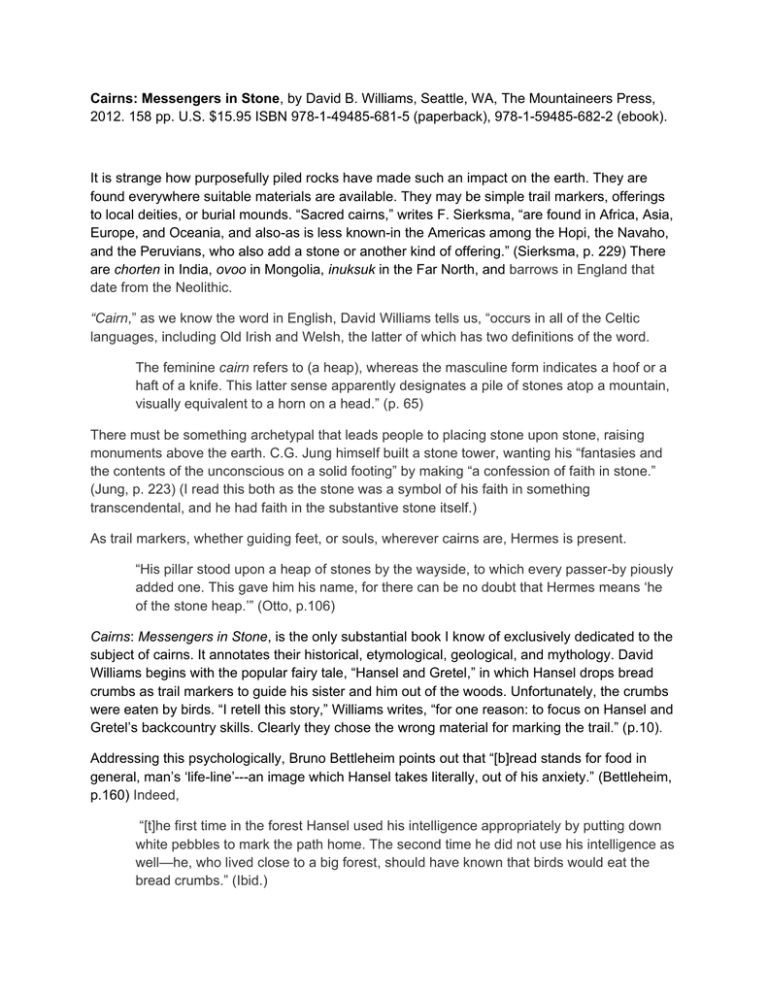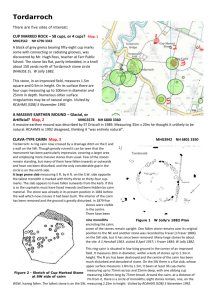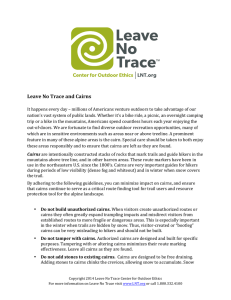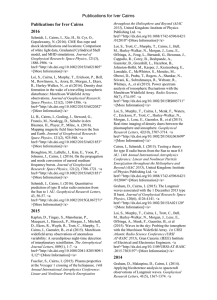Cairns: Messengers in Stone
advertisement

Cairns: Messengers in Stone, by David B. Williams, Seattle, WA, The Mountaineers Press, 2012. 158 pp. U.S. $15.95 ISBN 978-1-49485-681-5 (paperback), 978-1-59485-682-2 (ebook). It is strange how purposefully piled rocks have made such an impact on the earth. They are found everywhere suitable materials are available. They may be simple trail markers, offerings to local deities, or burial mounds. “Sacred cairns,” writes F. Sierksma, “are found in Africa, Asia, Europe, and Oceania, and also-as is less known-in the Americas among the Hopi, the Navaho, and the Peruvians, who also add a stone or another kind of offering.” (Sierksma, p. 229) There are chorten in India, ovoo in Mongolia, inuksuk in the Far North, and barrows in England that date from the Neolithic. “Cairn,” as we know the word in English, David Williams tells us, “occurs in all of the Celtic languages, including Old Irish and Welsh, the latter of which has two definitions of the word. The feminine cairn refers to (a heap), whereas the masculine form indicates a hoof or a haft of a knife. This latter sense apparently designates a pile of stones atop a mountain, visually equivalent to a horn on a head.” (p. 65) There must be something archetypal that leads people to placing stone upon stone, raising monuments above the earth. C.G. Jung himself built a stone tower, wanting his “fantasies and the contents of the unconscious on a solid footing” by making “a confession of faith in stone.” (Jung, p. 223) (I read this both as the stone was a symbol of his faith in something transcendental, and he had faith in the substantive stone itself.) As trail markers, whether guiding feet, or souls, wherever cairns are, Hermes is present. “His pillar stood upon a heap of stones by the wayside, to which every passer-by piously added one. This gave him his name, for there can be no doubt that Hermes means ‘he of the stone heap.’” (Otto, p.106) Cairns: Messengers in Stone, is the only substantial book I know of exclusively dedicated to the subject of cairns. It annotates their historical, etymological, geological, and mythology. David Williams begins with the popular fairy tale, “Hansel and Gretel,” in which Hansel drops bread crumbs as trail markers to guide his sister and him out of the woods. Unfortunately, the crumbs were eaten by birds. “I retell this story,” Williams writes, “for one reason: to focus on Hansel and Gretel’s backcountry skills. Clearly they chose the wrong material for marking the trail.” (p.10). Addressing this psychologically, Bruno Bettleheim points out that “[b]read stands for food in general, man’s ‘life-line’---an image which Hansel takes literally, out of his anxiety.” (Bettleheim, p.160) Indeed, “[t]he first time in the forest Hansel used his intelligence appropriately by putting down white pebbles to mark the path home. The second time he did not use his intelligence as well—he, who lived close to a big forest, should have known that birds would eat the bread crumbs.” (Ibid.) Here Bettleheim misses his own point that fairy tales are teaching stories with deeper meanings than the superficial story seems to imply. Cairns, too, may imply many more meanings and uses than meets the untrained eye. They come in many shapes and sizes. For example, “two narrow rocks placed vertically next to each other, a small pile located on one side of a trail fork, a massive pile high on a ridge and visible for miles, or a big rock with a little one on it pointing toward the correct route.” (p.10) In a bit of active imagination, Williams fantasizes Stone Age Homo habilus, who lived around 2.5 million years ago. “It seems obvious to me,” he writes, “that these earliest members of our genus must have built cairns. How else could they communicate to their kin that they were heading out to colonize new territory? Cairns, at least, would have also helped them on the return home.” (pp.16-17) In addition, as the picture of early humans that is emerging is more complex than we used to imagine, it is also possible that with various models of humanoids living at the same time (three found, so far), individual groups may have marked their territory with cairns, somewhat like other mammals use urine and other means. In the section titled “The Geology of Cairns,” the author lands in Ketflavik, Iceland, and gets “a glimpse of the cairn builder’s paradise....The only place the mid-Atlantic ridge appears on land is in Iceland, which has led to widespread and regular volcanism, a fantastic source of rock for cairns.” (pp.25-26) Discussing the many types of rocks, and which are best for piling atop each other, Williams gives us an informative non-technical overview of geology, then moves on to ecology, with such details as: “Because cairns form a three-dimensional space above a two-dimensional surface, they create habitat with niches for plants and animals to utilize. The additional elevation provides perches for birds and mammals. The nooks and crannies offer lizards and snakes safety from predators.” (p.41) And, Cairns may be teeming with life, themselves almost a living entity, “provid(ing) diverse spaces. both in the sun and in the shade.” (p.46) Spliced with tales of exploration and vignettes, Williams tracks cairns around the world, and down through time, traveling back to Bronze Age England and forward to New Age Hawaii, where there are posted signs asking visitors not to collect and build piles of stones, as they don’t ”just damage geologic evidence,” but “many sites (in the Volcanoes National Park are) sacred to Native Hawaiians,” and these were being desecrated by meaningless and misleading piles of rocks. (p.109) When Williams was a Ranger in Utah’s Arches National Park, although the Rangers built traditional cairns along the trails, some visitors decided they weren’t enough, adding their own cairns “leading from park trails to some exciting feature they had discovered.” (p.14) There were also some people that leveled the Rangers’ cairns “and built their own in hopes of leading other visitors astray.” (p.15) (Is this Hermes as trickster, who guides souls both up and down, who sometimes leads tourists astray?) There’s some poetry here too, as in the 1700s, “and maybe earlier, a tradition began in Iceland of leaving writings in the leg bone of an animal, such as a cow or sheep, and embedding that bone in a cairn.” (p.128) These structures served as a post office, or message board. Here’s one that reads like a sex wanted ad: “May all be welcomed that want to have me I can’t be satisfied Alone on the mountain.” (p.129) Down the coast from Seattle, where David Williams makes his home, in 1965, poets Allen Ginsberg, Gary Snyder and Philip Whalen began a tradition of circumambulating Mt. Tamalpais, a mountain just north of San Francisco. Stopping several times along the winding path to the summit, they, and subsequent sojourners, chanted a Buddhist dhārāni, bowed, and added stones to cairns by the wayside. It seemed a simple act; but after reading this book, I will never again look at a cairn without recalling how complex a pile of stones can be. References: Bettelheim, B. (1976) The Uses of Enchantment. New York: Alfred A. Knopf. Jung, C.G. (1965) Memories, Dreams, Reflections. New York: Vintage. Otto, Walter F. (1954) The Homeric Gods. New York: Pantheon. Sierksma, F. (1963) Sacred Cairns in Pastoral Cultures.” History of Religions, Vol. 2, No. 2 (Winter).











